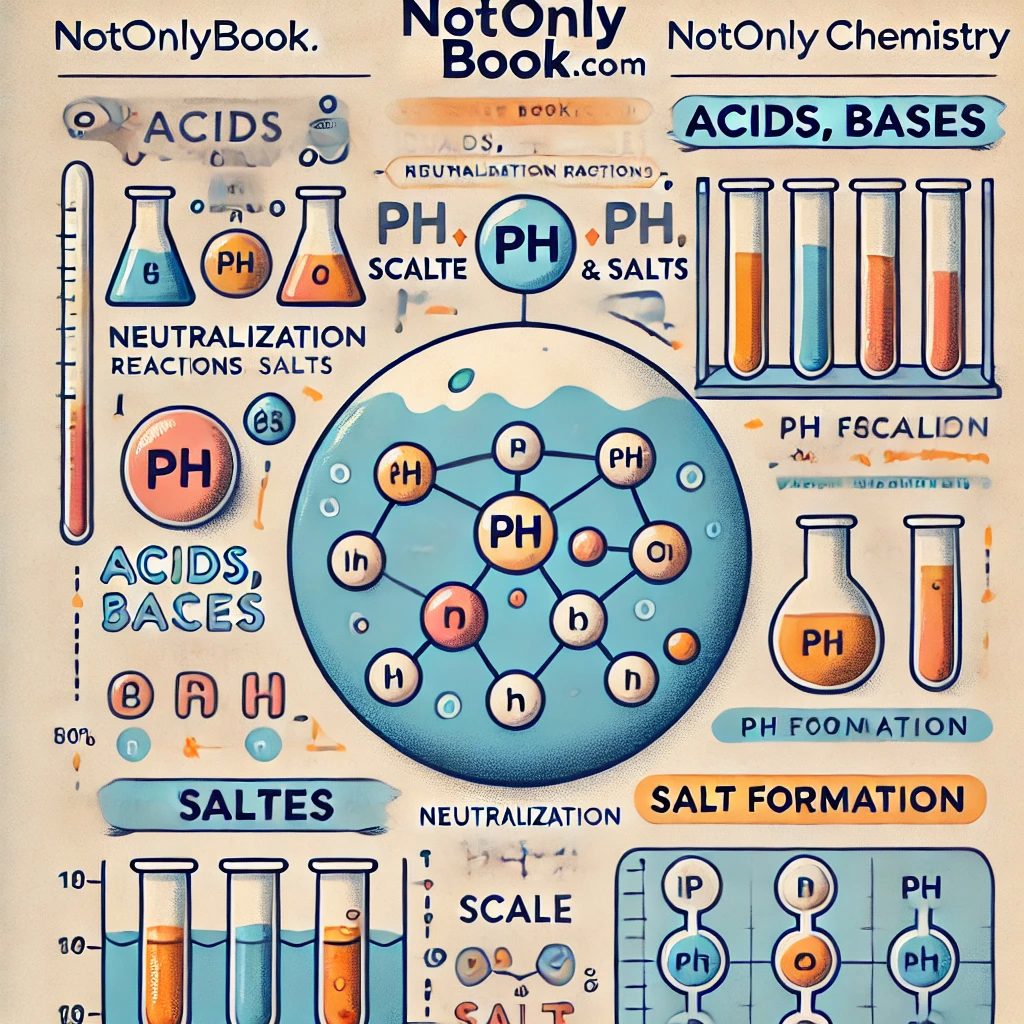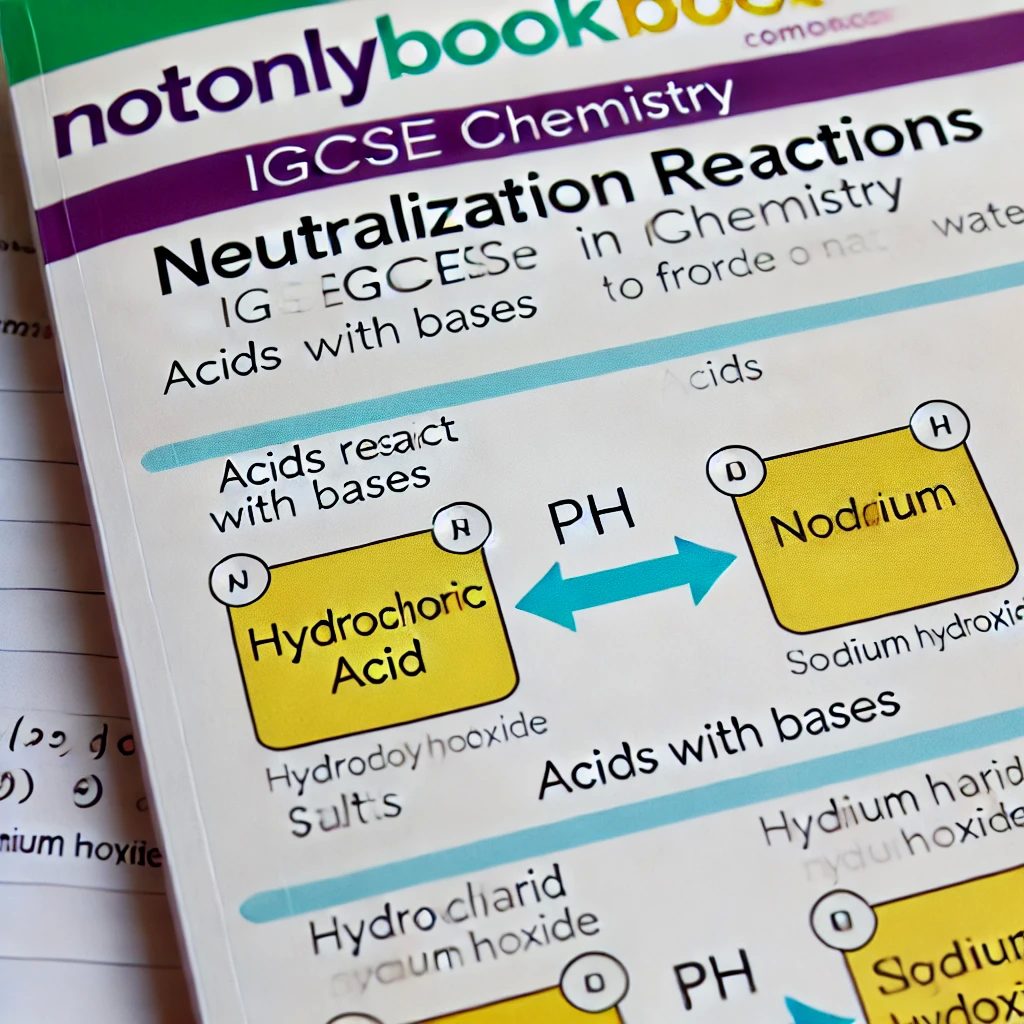Table of Contents
, bases, and salts are fundamental concepts in Chemistry and play a crucial role in various reactions, processes, and everyday applications. Understanding the properties, reactions, and uses of acids and bases, as well as how salts are formed, is a core component of the IGCSE Chemistry syllabus. This article will provide a detailed overview of these topics, exploring definitions, reactions, and real-world applications.
What Are Acids and Bases?
In Chemistry, and bases are substances that can donate or accept protons (H+^++ ions) in reactions. They are often classified based on their ability to either release hydrogen ions (for ) or hydroxide ions (for bases) when dissolved in water.
- : An acid is any substance that donates H+^++ ions when dissolved in water. Common examples include hydrochloric acid (HCl), sulfuric acid (H2_22SO4_44), and nitric acid (HNO3_33). have a pH lower than 7, turn blue litmus paper red, and react with bases to form salts and water.
- Bases: A base is any substance that accepts H+^++ ions or releases hydroxide ions (OH−^-−) when dissolved in water. Sodium hydroxide (NaOH) and potassium hydroxide (KOH) are common bases. Bases have a pH greater than 7, turn red litmus paper blue, and react with to neutralize them.
- Alkalis: Alkalis are a specific type of base that is soluble in water and releases hydroxide ions (OH−^-−) in solution. Examples include sodium hydroxide and calcium hydroxide.
Properties of Acids and Bases
Understanding the properties of acids and bases helps explain their behavior in reactions and applications.
- Acid Properties:
- Taste: have a sour taste (e.g., lemon juice contains citric acid).
- Reaction with Metals: react with metals like zinc or magnesium to produce hydrogen gas.
- Reaction with Carbonates: react with carbonates to produce carbon dioxide, water, and salt.
- Base Properties:
- Taste and Feel: Bases have a bitter taste and a slippery feel.
- Reaction with Acids: Bases neutralize to produce water and salt.
- Conductivity: Both acids and bases conduct electricity when dissolved in water due to ion formation.
- Royal Society of Chemistry – Properties of Acids and Bases
The pH Scale
The pH scale is used to measure the acidity or alkalinity of a solution. The scale ranges from 0 to 14, where:
- pH < 7: Acidic solutions (e.g., lemon juice, vinegar)
- pH = 7: Neutral solutions (e.g., pure water)
- pH > 7: Alkaline solutions (e.g., soap solution)
A universal indicator or pH paper can be used to determine the pH of a substance, changing color according to the pH value.
Neutralization Reactions
A neutralization reaction occurs when an acid and a base react to form water and a salt. This type of reaction is fundamental to many chemical processes, including digestion, industrial waste treatment, and agriculture.
The general equation for a neutralization reaction is:Acid+Base→Salt+Water\text{Acid} + \text{Base} \rightarrow \text{Salt} + \text{Water}Acid+Base→Salt+Water
For example, when hydrochloric acid reacts with sodium hydroxide, the products are sodium chloride (a salt) and water:HCl+NaOH→NaCl+H2OHCl + NaOH \rightarrow NaCl + H_2OHCl+NaOH→NaCl+H2O
Salts and Their Formation
Salts are ionic compounds formed from the neutralization of an acid by a base. They consist of a positive ion (from the base) and a negative ion (from the acid).
- Common Types of Salts:
- Sodium chloride (NaCl): Formed from hydrochloric acid and sodium hydroxide, it’s the most common salt, used in food seasoning.
- Calcium carbonate (CaCO3_33): Found in limestone and chalk, it is used in construction and manufacturing.
- Ammonium sulfate (NH4)2SO4(NH_4)_2SO_4(NH4)2SO4: Used as a fertilizer, formed from sulfuric acid and ammonia.
- Uses of Salts:
- In Food: Salts like sodium chloride are essential in food preservation and flavoring.
- In Industry: Salts like ammonium nitrate are used in fertilizers, while others are used in manufacturing and cleaning products.
- Types and Uses of Salts – BBC Bitesize
Applications of Acids and Bases
- In Industry:
- Acids such as sulfuric acid are used in the manufacture of fertilizers, batteries, and detergents.
- Bases like sodium hydroxide are used in soap production, paper manufacturing, and chemical synthesis.
- In Daily Life:
- Vinegar, which contains acetic acid, is used in cooking and cleaning.
- Antacids, which contain weak bases, are used to neutralize excess stomach acid.
- Everyday Uses of Acids and Bases – ThoughtCo

Conclusion
Understanding the chemistry of acids, bases, and salts is vital for grasping how many reactions occur in both industrial and biological systems. From the neutralization of stomach acid to the production of fertilizers, acids and bases play essential roles in daily life. The IGCSE syllabus ensures students are equipped with the knowledge to apply these concepts in practical and real-world contexts.





No comment